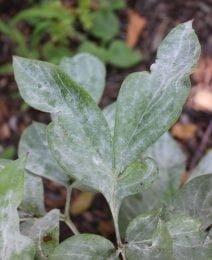Powdery Mildew
 Powdery mildew has been an issue this year. Powdery mildew produces a white powdery substance that grows on the upper leaf surfaces of the lower leaves. These leaves and others may become twisted, distorted, and then wilt and die due to having been infected with this fungus. Powdery mildew is favored by high relative humidity at night (which favors fungal spore formation), low relative humidity during the day (which favors spore dispersal), and temperatures of 70 to 80 degrees. Powdery mildews are parasitic fungi that can only utilize the nutrients of a live host plant. Although the powdery mildew seldom kills its hosts, the fungi reduce the amount of photosynthesis taking place, increase respiration and transpiration, and cause slower growth.
Powdery mildew has been an issue this year. Powdery mildew produces a white powdery substance that grows on the upper leaf surfaces of the lower leaves. These leaves and others may become twisted, distorted, and then wilt and die due to having been infected with this fungus. Powdery mildew is favored by high relative humidity at night (which favors fungal spore formation), low relative humidity during the day (which favors spore dispersal), and temperatures of 70 to 80 degrees. Powdery mildews are parasitic fungi that can only utilize the nutrients of a live host plant. Although the powdery mildew seldom kills its hosts, the fungi reduce the amount of photosynthesis taking place, increase respiration and transpiration, and cause slower growth.
Suppose powdery mildew occurs in the late summer or fall. In that case, applying a fungicide is usually unnecessary, since the plant will have stored sufficient energy to flower and put on foliage the following spring. However, when powdery mildew attacks in the spring or early summer, it may be necessary to spray an appropriate fungicide to control the disease. A fungicide can be applied as soon as the first symptoms appear, with follow-up sprays every 7 to 14 days while conditions are favorable for the growth and spread of this disease. Labeled products include chlorothalonil, myclobutanil, propiconazole, and copper-containing fungicides.

Have questions? Contact our office where our Horticulture Extension Agent will assist you with questions.
Phone: (316) 321-9660
Email: callae@ksu.edu